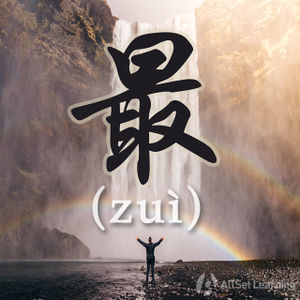Difference between revisions of "Superlative "zui""
m (Text replace - "Adjectives and Adverbs" to "Adverbs with Adjectives") |
|||
| Line 2: | Line 2: | ||
The most common way to form a superlative (best, worst, thinnest, fattest etc.) in Chinese is to use 最 (zuì). | The most common way to form a superlative (best, worst, thinnest, fattest etc.) in Chinese is to use 最 (zuì). | ||
| − | == Basic | + | == Basic Structure == |
The structure is: | The structure is: | ||
| Line 14: | Line 14: | ||
And now you have the superlative form of the adjective. Unlike in English, this structure is consistent for all adjectives in Chinese. | And now you have the superlative form of the adjective. Unlike in English, this structure is consistent for all adjectives in Chinese. | ||
| − | + | == Examples == | |
<div class="liju"> | <div class="liju"> | ||
| − | * 他 <em>最</em> | + | * 他 <em>最</em> 笨。 |
* 你 <em>最</em> 胖。 | * 你 <em>最</em> 胖。 | ||
* 我 <em>最</em> 矮。 | * 我 <em>最</em> 矮。 | ||
| Line 34: | Line 34: | ||
</div> | </div> | ||
| − | + | == Examples == | |
<div class="liju"> | <div class="liju"> | ||
* 他 <em>最</em> 聪明 了。 | * 他 <em>最</em> 聪明 了。 | ||
| − | * 你 <em>最</em> | + | * 你 <em>最</em> 瘦 了。 |
| − | * 我 <em>最</em> | + | * 我 <em>最</em> 高 了。 |
</div> | </div> | ||
==See also== | ==See also== | ||
| + | |||
*[[Expressing "excessively" with tai]] | *[[Expressing "excessively" with tai]] | ||
*[[Positive adjectives with "-ji le"]] | *[[Positive adjectives with "-ji le"]] | ||
Revision as of 10:05, 14 August 2012
-
Level
-
Similar to
-
Used for
-
Keywords
The most common way to form a superlative (best, worst, thinnest, fattest etc.) in Chinese is to use 最 (zuì).
Contents
Basic Structure
The structure is:
最 + Adjective
And now you have the superlative form of the adjective. Unlike in English, this structure is consistent for all adjectives in Chinese.
Examples
- 他 最 笨。
- 你 最 胖。
- 我 最 矮。
Optional 了
Occasionally you'll also see a 了 added after the adjective. This just adds emphasis to the "-est."
最 + Adjective + 了
Examples
- 他 最 聪明 了。
- 你 最 瘦 了。
- 我 最 高 了。
See also
- Expressing "excessively" with tai
- Positive adjectives with "-ji le"
- Expressing "rather" with "bijiao"
Sources and further reading
Books
- New Practical Chinese Reader 3 (新实用汉语课本3) (pp. 15-6) →buy



